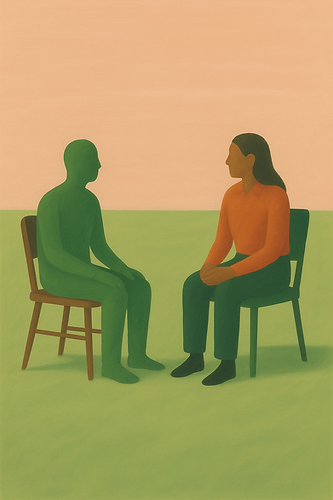
Rooted in research, guided by compassion.
What is DBT & what does it address?
Dialectical Behavior Therapy (DBT) is a structured, skills-based approach that helps you build emotional regulation, deepen self-awareness, and feel more in control — without ignoring the pain you carry. It’s not about fixing you. It’s about helping you make sense of your inner world, and learning how to care for yourself in it.
When emotions feel too big, and the tools you’ve tried just aren’t working — DBT can help.
If you’ve been told you’re “too sensitive,” “too reactive,” or “too much,” you’re not alone. Maybe your feelings overwhelm you, your relationships feel volatile, or you shut down completely when things get hard. DBT offers concrete tools that you can use in the moment to self-regulate and overtime helps you build a tolerance for distress in the real world.
At Boundless, we offer DBT that’s compassionate, trauma-informed, and tailored to you — not textbook. By pairing what works, with our common humanity, we facilitate therapy that gets your results.
How can DBT help you?
You don’t have to feel “out of control” to benefit from DBT. This approach is ideal for anyone who feels stuck in patterns of emotional reactivity, black-and-white thinking, or chronic self-doubt.
DBT may be especially helpful if you:
-
Feel overwhelmed by your emotions or reactions
-
Struggle to set boundaries or ask for your needs
-
Experience impulsive behavior or difficulty self-soothing
-
Want to strengthen your communication in relationships
-
Live with BPD, C-PTSD, ADHD, anxiety, or depression
At its heart, DBT is about building a life that feels more intentional, manageable, and aligned with your values.

A little about our approach to DBT.
So you know what to expect!
At Boundless, we offer a relational, culturally-attuned approach to DBT that honors both your lived experience and your inner wisdom. While some DBT frameworks can feel rigid or overly clinical, our clinicians integrate Relational principles—bringing warmth, flexibility, and genuine connection into the work.
In session, DBT might look like:
-
Learning concrete skills for managing overwhelm
-
Exploring how family dynamics, cultural values, or systemic pressures shape your emotional responses
-
Role-playing tough conversations to practice assertiveness
-
Using mindfulness to observe your inner world without judgment
Your therapist won’t just hand you a worksheet. They’ll help you make the skills real—in your body, your relationships, and your day-to-day life.
What a DBT treatment plan looks like at Boundless.
1. Orientation & Foundations
You’ll begin by building rapport with your therapist and getting clear on what’s bringing you in. We’ll set goals collaboratively and begin learning foundational tools — from grounding strategies to emotional tracking — so you feel supported from the very start.
2. Skills Practice & Real-Life Application
Once we’ve built trust and structure, we’ll move into the core DBT skill areas:
-
Mindfulness to notice what’s happening without judgment
-
Distress Tolerance to survive the storm without making it worse
-
Emotion Regulation to better understand, name, and shift what you feel
-
Interpersonal Effectiveness to navigate boundaries, conflict, and connection
We don’t just teach these skills — we practice them together, using examples from your actual life. Your therapist helps you troubleshoot in real time so the tools stick beyond the session.
3. Integration & Long-Term Growth
As you begin to use DBT skills more naturally, sessions shift toward deepening insight, strengthening patterns that are working, and exploring any remaining blocks. You’ll leave with a toolkit — not just of strategies, but of self-trust.
Throughout the process, relationship comes first.
At Boundless, DBT isn’t delivered like a class. It’s a co-created process — one where your therapist walks with you, not ahead of you.
